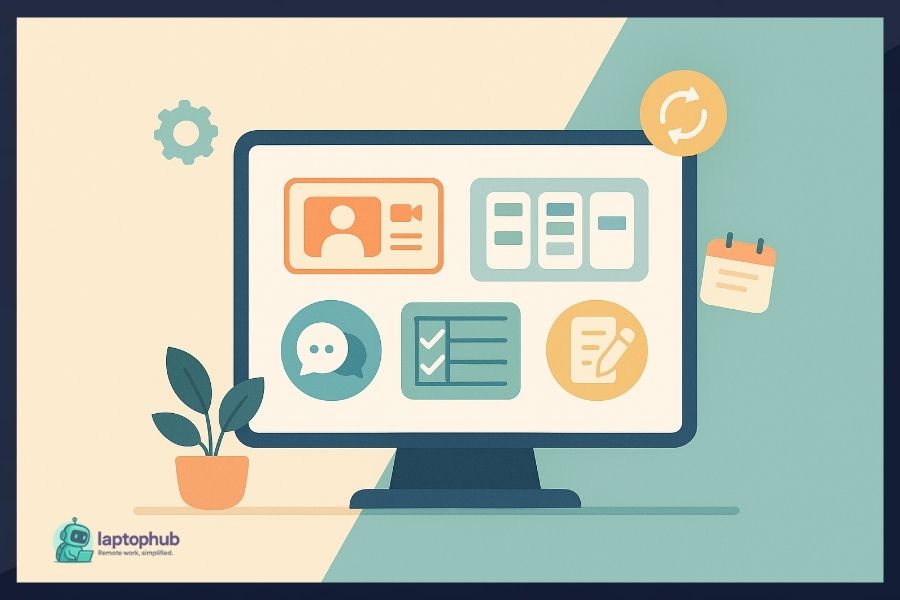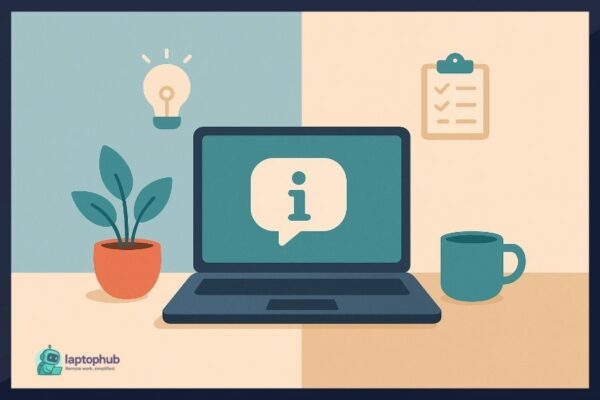Remote work isn’t a trend anymore—it’s the standard. As we move through 2025, the demand for effective remote work tools keeps growing. Whether you’re a freelancer, part of a distributed team, or managing a global workforce, the right software stack can make or break productivity.
This guide covers the best remote work tools and apps in 2025, broken down by categories like communication, project management, collaboration, security, time tracking, and more. We’ve evaluated them for features, usability, and what makes them stand out this year.
💡Key takeaways:
- Remote work is now the standard, and having the right tools directly impacts productivity, collaboration, and team culture.
- The best remote work tools in 2025 offer AI features, seamless integrations, and support for both real-time and asynchronous workflows.
- Security, time management, and team connection are just as important as project tracking and communication tools.
- There’s no universal solution—choosing the right tools depends on your team’s size, workflow, and work culture.
Why Choosing the Right Remote Work Tools Matters
Remote teams face challenges that don’t exist in traditional office settings—disconnected communication, lack of visibility, time zone differences, and burnout from blurred work-life boundaries.
With the right tools, you can:
- Streamline workflows
- Reduce miscommunication
- Boost productivity
- Maintain accountability
- Support employee well-being
Let’s get into the top-performing remote work tools in 2025.
Best Remote Work Tools in a Glance
| Category | Tool | Purpose | Best For |
|---|---|---|---|
| Communication | Slack | Real-time messaging + integrations | Fast-paced teams needing quick conversations |
| Zoom 2.0 | Video meetings + AI recaps | Teams running regular meetings and calls | |
| Microsoft Teams | Chat + video + Office 365 integration | Microsoft-based organizations | |
| Project Management | ClickUp | All-in-one project/task/workflow hub | Cross-functional teams with complex projects |
| Notion | Docs + project tracking + AI workspace | Creative or startup teams needing flexibility | |
| Asana | Task tracking + timelines + automation | Teams needing visibility and accountability | |
| Collaboration | Miro | Digital whiteboard for brainstorming | Product, design, and remote strategy teams |
| Google Workspace | Docs, Sheets, Slides for co-authoring | Teams needing document-based collaboration | |
| Loom | Async video recording & sharing | Explaining tasks or updates without meetings | |
| Time/Productivity | Toggl Track | Time tracking + productivity reports | Freelancers and client-focused teams |
| Serene | Focus sessions + daily planning | Individuals struggling with distractions | |
| RescueTime | Time analytics + productivity coaching | Professionals seeking behavior insights | |
| File Sharing & Storage | Dropbox | Secure cloud storage + e-signatures | Teams handling media or legal documents |
| OneDrive + Microsoft 365 | Storage with deep Office integration | Enterprises using Microsoft tools | |
| Box | Secure file sharing + workflow automation | Enterprise teams needing compliance | |
| Security & Access | 1Password | Password manager with team access | Any remote team managing multiple logins |
| NordLayer | Secure remote access + network protection | Companies with sensitive remote workflows | |
| Proton VPN + Pass | Privacy-first VPN + password vault | Teams focused on security and open-source tools | |
| Team Culture & Connection | Gather | Virtual office with avatars + rooms | Teams wanting casual, spontaneous connection |
| Donut | Random pairing + team culture for Slack | Bonding and recognition in Slack-based teams | |
| Icebreaker.video | Virtual team-building with guided prompts | Creating stronger social bonds in remote teams |
Best Communication Tools
Slack
Why it’s still a favorite in 2025: Slack keeps evolving. In 2025, it integrates tightly with AI bots, workflow builders, and external tools like Notion, Asana, and Google Drive. Slack’s latest update includes AI-powered message summarization, automatic follow-up reminders, and better noise reduction in huddles.
Key Features:
- Channels for topic-based conversations
- Huddles for fast voice chats
- AI-driven search and summaries
- Deep integrations with other platforms
Best For: Teams of all sizes needing real-time collaboration.
Zoom
Zoom continues to dominate video conferencing, but in 2025, it’s smarter. Its new AI assistant offers real-time transcription, live translation in 30+ languages, and meeting recaps with action items.
Key Features:
- Crystal-clear HD calls
- AI recaps + summaries
- Persistent meeting threads
- Breakout rooms and whiteboards
Best For: Teams running frequent client meetings or internal check-ins.
Microsoft Teams
Microsoft Teams remains a strong choice for companies that rely on Microsoft 365. In 2025, it features smarter AI call summaries, better task integration via Planner, and enhanced breakout room controls—making it great for structured team collaboration.
Best for: Organizations already embedded in the Microsoft ecosystem.
Best Project Management Tools
ClickUp
ClickUp has grown into an all-in-one productivity platform. In 2025, it offers seamless integration with GitHub, Google Workspace, Zoom, and over 100 tools. Its AI copilot helps write tasks, estimate timelines, and auto-prioritize work.
Key Features:
- Customizable views (Board, List, Gantt, Calendar)
- Native Docs and Whiteboards
- Time tracking and goal-setting
- ClickUp AI assistant
Best For: Teams managing complex projects with lots of moving parts.
Notion
Notion isn’t just a note-taking tool anymore. It’s now a full project and knowledge management system. With Notion AI, users can generate content, automate task creation, and summarize meeting notes.
Key Features:
- Database, Kanban, and calendar views
- AI features built-in for summarizing and generating tasks
- Shared wikis and team knowledge base
Best For: Startups and creative teams who want flexibility and minimal setup.
Asana
Asana continues to be a favorite among remote teams thanks to its clean interface, automation workflows, and timeline view. Its 2025 update includes AI-powered task suggestions, workload balancing, and smarter cross-project dependencies.
Best for: Teams that prioritize transparency and structured task planning.
Best Collaboration Tools
Miro
Miro continues to lead in digital whiteboarding. In 2025, it’s optimized for hybrid brainstorming sessions and includes real-time AI suggestions for idea mapping, flowchart design, and workshop templates.
Key Features:
- Infinite canvas
- Templates for workflows, mind maps, retros
- AI brainstorming helper
- Real-time multiplayer editing
Best For: Remote product, UX, and strategy teams.
Google Workspace
Still the default for remote file collaboration. Google Docs, Sheets, and Slides have better co-authoring tools in 2025, plus real-time AI grammar fixes, tone checks, and presentation polishing with one click.
Key Features:
- Live editing and version history
- Deep collaboration tools
- AI content assistant across all apps
- Secure cloud storage
Best For: Any team needing smooth document collaboration.
Loom
Loom is a powerful tool for async communication, letting you record quick videos instead of writing long messages or scheduling meetings. In 2025, it adds auto-captioning, voice cleanup, and AI-generated video summaries.
Best for: Explaining complex tasks, onboarding, or giving feedback without live calls.
Best Time Management & Productivity Tools
Toggl Track
For freelancers and teams tracking billable hours, Toggl Track is clean, accurate, and integrates with most major platforms. In 2025, it adds calendar sync, automated time suggestions, and detailed productivity analytics.
Key Features:
- Manual + automated tracking
- Reports + invoicing
- Team dashboards
- AI-based time logging suggestions
Best For: Remote teams and freelancers who bill hourly or need clear productivity insights.
Serene
A newer player, Serene is built for focus. In 2025, it uses light gamification, Pomodoro cycles, and personalized music to block distractions and boost deep work.
Key Features:
- Focus sessions with timers
- Distraction blockers
- Mood-based music playlists
- Daily planning dashboards
Best For: Individuals struggling with remote work distractions.
RescueTime
RescueTime automatically tracks where your time goes and provides detailed productivity scores. Its 2025 dashboard includes AI goal-setting, focus suggestions, and burnout risk alerts based on your digital behavior.
Best for: Remote workers wanting deep insight into their habits and time use.
📖Also read: Remote Work Productivity Tips for Building Focus and Beating Distractions
Best File Sharing & Storage Tools
Dropbox
Dropbox remains a go-to for cloud storage, but in 2025, it stands out with smart sync, version control, and advanced team permissions. It also has a built-in e-signature tool now.
Key Features:
- Secure file syncing
- Dropbox Sign (formerly HelloSign)
- AI-powered file search
- Shared team folders with access controls
Best For: Teams handling large files like media, legal docs, or client deliverables.
OneDrive + Microsoft 365
Ideal for enterprises already deep in the Microsoft ecosystem. In 2025, it offers tight SharePoint integration, AI co-authoring in Word/Excel, and end-to-end encryption.
Best For: Enterprises and organizations standardized on Microsoft tools.
Box
Box focuses on secure file sharing for enterprise teams, and in 2025, it offers zero-trust data access controls, workflow automation, and machine learning-based content classification.
Best for: Teams needing compliance-grade file management with robust permissions.
Best Security & Privacy Tools
1Password
1Password is critical for distributed teams managing dozens of tools. In 2025, it adds biometric login, dark web monitoring, and vault access analytics.
Key Features:
- End-to-end encrypted password vaults
- Role-based access
- Browser extensions for auto-fill
- Secure team sharing
Best For: Any remote team serious about digital hygiene.
NordLayer
Built for businesses, NordLayer protects remote access and company networks. It’s not just a VPN—it includes Zero Trust Network Access (ZTNA), network segmentation, and multi-factor authentication.
Key Features:
- Secure remote access
- Device compliance checks
- Centralized management console
- Global infrastructure for fast speeds
Best For: Companies with remote workers accessing sensitive systems.
Proton VPN + Proton Pass
Proton offers a privacy-first VPN and password manager suite built in Switzerland with open-source encryption. Their tools are now tailored for teams, with secure team vaults, split tunneling, and multi-admin management.
Best for: Privacy-focused teams who want open-source, non-corporate alternatives.
Best Virtual Office & Culture Tools
Gather
Gather turns remote work into a game-like experience. Teams move around virtual offices, meet casually, and join rooms for spontaneous chats. In 2025, it’s faster, sleeker, and supports hybrid presence awareness.
Key Features:
- Customizable virtual spaces
- Video/audio chat in rooms
- Avatar-based presence
- Screen sharing & embedded apps
Best For: Teams looking to rebuild casual watercooler culture.
Donut
Built for Slack, Donut randomly pairs team members for virtual coffee chats. In 2025, it supports team bonding templates, shoutouts, and peer recognition programs.
Best For: Fostering team connection and morale in distributed teams.
Icebreaker.video
Icebreaker is designed for team-building with quick, guided video chats. In 2025, it’s used to host virtual events, run icebreaker rounds, and foster informal connections in distributed teams.
Best for: Companies that want to humanize remote work and spark meaningful conversation.
How to Choose the Right Remote Work Tools in 2025
With hundreds of tools out there, choosing the right ones for your remote team isn’t about finding the flashiest features—it’s about solving actual workflow problems. A good tool should remove friction, not add to it. Here’s how to evaluate and build the right remote tool stack this year:
1. Map Your Team’s Workflow First
Before even looking at software, break down your daily and weekly workflows. Ask:
- How do we communicate—real-time or async?
- What types of projects do we manage?
- How do we track progress, share files, and give feedback?
- Where are the bottlenecks?
Once you know where the pain points are—like unclear handoffs, time zone delays, or poor task visibility—you can choose tools that directly address them.
2. Prioritize Integration Over Feature Overload
It’s tempting to pick tools loaded with features. But if they don’t play nice with your existing stack, you’ll end up context-switching constantly. That’s a productivity killer.
What to look for:
- Native integrations with Slack, Google Workspace, Zoom, etc.
- API support or tools like Zapier/Make for automation
- SSO (Single Sign-On) and unified logins for smoother onboarding
Tools that integrate well reduce redundancy, keep your data centralized, and help your team move faster.
3. Go Asynchronous by Default
Remote work doesn’t mean everyone is online at the same time. Embrace async-first tools—ones that allow people to contribute, update, or reply on their own schedules.
Examples of async-friendly tools:
- Loom for explainer videos
- Notion or ClickUp Docs for updates
- Project boards like Asana or Trello instead of constant chat threads
The more your tools support async work, the less dependent you are on meetings and overlapping hours.
4. Choose Tools That Scale With You
Startups might get away with basic tools, but as your team grows, you’ll need admin controls, permissions, analytics, and usage limits that don’t get in your way.
Questions to ask:
- Can this tool support 50+ users or multiple teams?
- Does the pricing structure make sense as we scale?
- Are there role-based permissions or approval flows?
Pick platforms that can grow with your team, not ones you’ll have to rip and replace in six months.
5. Don’t Overload Your Team With Tools
More tools ≠ more productivity. If your stack gets bloated, it becomes confusing, expensive, and overwhelming. Be ruthless about overlap—if two apps do the same thing, cut one.
Tips:
- Do a quarterly audit of your tech stack
- Survey your team: “Which tools feel essential? Which feel like noise?”
- Consolidate where possible (e.g., use ClickUp instead of 3 separate tools for docs, tasks, and tracking)
The best tools fade into the background and just work.
6. Focus on UX and Ease of Onboarding
Even the most powerful tool won’t help if your team struggles to use it. Choose apps with clean design, mobile compatibility, and minimal onboarding friction.
Try before you commit:
- Set up a trial and have a few team members test real workflows
- Evaluate how quickly they can learn the system without training
- Look for good support docs, tutorials, and live chat
If it’s not intuitive, adoption will suffer—and so will ROI.
7. Check for Security, Privacy & Compliance
Remote teams often work across countries, devices, and unsecured networks. Security isn’t optional anymore—it’s foundational.
Make sure your tools offer:
- End-to-end encryption
- Two-factor authentication (2FA)
- Role-based access controls
- Compliance with GDPR, SOC 2, HIPAA (if applicable)
If you handle client data, IP, or sensitive financial info, these features are non-negotiable.
8. Balance Cost with Long-Term ROI
Don’t just look at monthly fees—consider what each tool actually saves or earns you in return. A $10/month tool that saves five hours of confusion is worth it.
Ask:
- How much time will this save per person, per week?
- Will it reduce meetings or manual updates?
- Will it help us deliver better work, faster?
Budget matters, but productivity and morale matter more.
9. Start Simple, Then Expand
You don’t need 15 apps on day one. Start with core tools for:
- Communication
- Project tracking
- File sharing
- Security
Once those are solid, expand into nice-to-haves like team-building, time tracking, or automation tools.
Final Tip: Let Your Team Help Shape the Stack
Your tech stack should be shaped by the people using it daily. Get feedback early, involve key team members in decisions, and build buy-in through small pilots before you roll out tools company-wide.
Remember: The best remote tools aren’t just about features. They’re about fit.
Remote Work Tools FAQs
1. What are the must-have remote work tools in 2025?
Must-have tools include Slack or Zoom for communication, ClickUp or Notion for project management, Miro for collaboration, and 1Password or NordLayer for security.
2. How do I choose the right tools for my remote team?
Look for tools that match your workflow, support asynchronous communication, integrate with existing software, and scale with your team.
3. What’s new in remote work tools in 2025?
AI integration, real-time collaboration features, security-first design, and smarter time tracking are top trends in remote work software this year.
4. Are there free tools for remote work?
Yes—tools like Google Workspace, Notion (personal plan), Slack (free tier), and Toggl Track offer robust free versions with upgrade options.
5. Why is tool integration important for remote teams?
Integrated tools reduce app-switching, automate repetitive tasks, and keep communication and workflows streamlined across platforms.
Final Thoughts
Remote work is only getting more powerful—but only if you have the right setup. The best remote work tools in 2025 aren’t just about checking boxes; they enhance communication, clarify expectations, and reduce friction.
If your current tools aren’t helping you move faster, collaborate better, or feel more connected, it’s time to reassess.
Ready to level up your remote toolkit? Start with 2–3 upgrades from this list and build from there.




